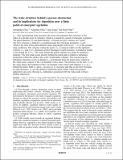The wake structure behind a porous obstruction and its implications for deposition near a finite patch of emergent vegetation
Author(s)
Chen, Zhengbing; Ortiz, Alejandra Campbell; Zong, Lijun; Nepf, Heidi
DownloadChen (2).pdf (1.040Mb)
PUBLISHER_POLICY
Publisher Policy
Article is made available in accordance with the publisher's policy and may be subject to US copyright law. Please refer to the publisher's site for terms of use.
Terms of use
Metadata
Show full item recordAbstract
This experimental study describes the mean and turbulent flow structure in the wake of a circular array of cylinders, which is a model for a patch of emergent vegetation. The patch diameter, D, and patch density, a (frontal area per volume), are varied. The flow structure is linked to a nondimensional flow blockage parameter, C[subscript D]aD, which is the ratio of the patch diameter and a drag length scale (C[subscript D]a)[superscript −1]. C[subscript D] is the cylinder drag coefficient. The velocity exiting the patch, U[subscript e], is reduced relative to the upstream velocity, U[subscript ∞], and U[subscript e]/U[subscript ∞] decreases as flow blockage (C[subscript D]aD) increases. A predictive model is developed for U[subscript e]/U[subscript ∞]. The wake behind the patch contains two peaks in turbulence intensity. The first peak occurs directly behind the patch and is related to turbulence production within the patch at the scale of individual cylinders. The second peak in turbulence intensity occurs at distance L[subscript w]downstream from the patch and is related to the wake-scale vortices of the von Karman vortex street. The presence of the flow U[subscript e] in the wake delays the formation of the von Karman vortex street until distance L[subscript 1] (<L[subscript w]) behind the patch. Both L[subscript 1] and L[subscript w] increase as U[subscript e] increases and thus as the flow blockage (C[subscript D]aD) decreases. L1sets the distance behind the patch within which fine-particle deposition can occur. BeyondLw, turbulence associated with the wake-scale vortices inhibits deposition.
Date issued
2012-09Department
Massachusetts Institute of Technology. Department of Civil and Environmental EngineeringJournal
Water Resources Research
Publisher
American Geophysical Union (Wiley platform)
Citation
Chen, Zhengbing et al. “The Wake Structure Behind a Porous Obstruction and Its Implications for Deposition Near a Finite Patch of Emergent Vegetation.” Water Resources Research 48.9 (2012). ©2012 John Wiley & Sons, Inc
Version: Final published version
ISSN
0043-1397